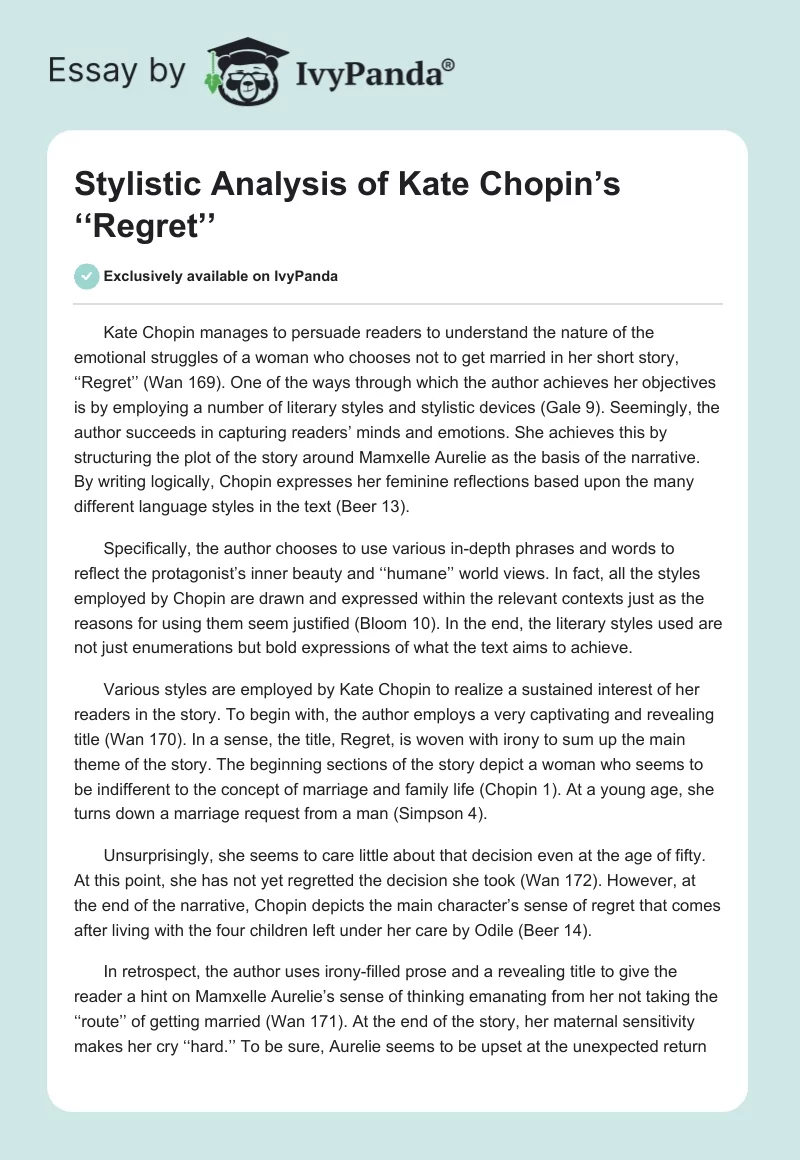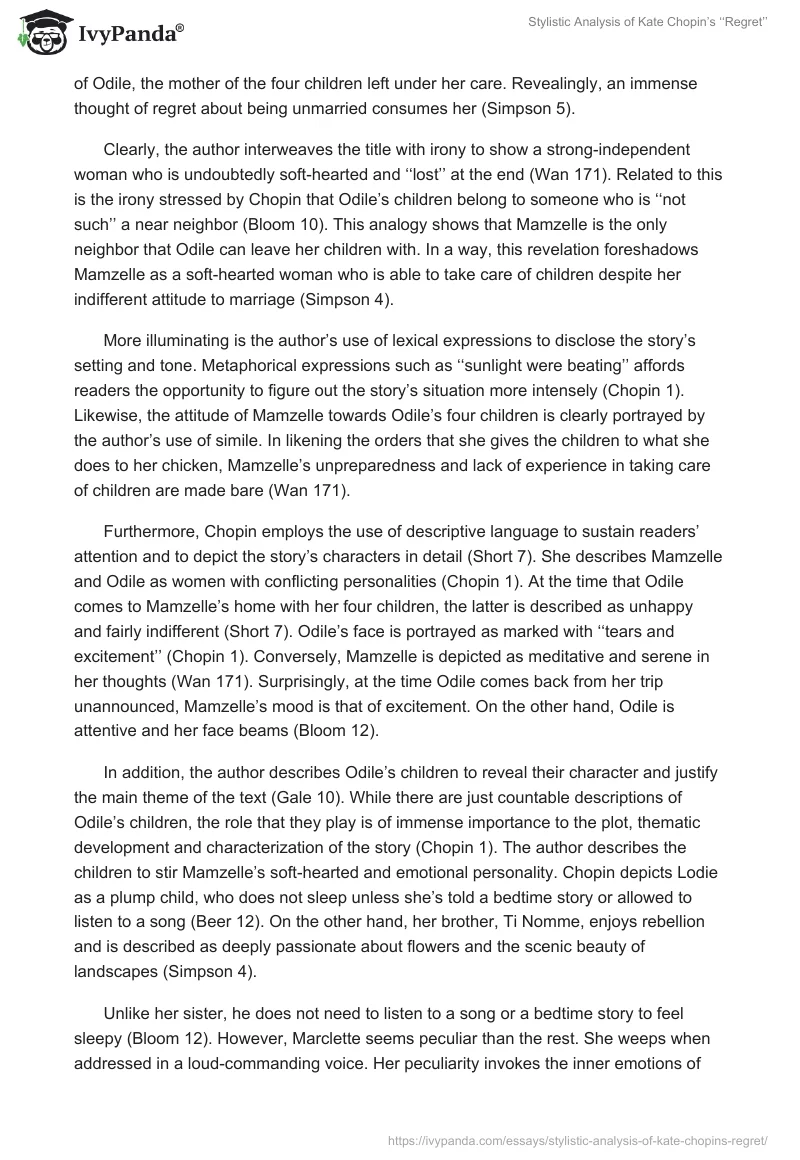Kate Chopin manages to persuade readers to understand the nature of the emotional struggles of a woman who chooses not to get married in her short story, ‘‘Regret’’ (Wan 169). One of the ways through which the author achieves her objectives is by employing a number of literary styles and stylistic devices (Gale 9). Seemingly, the author succeeds in capturing readers’ minds and emotions. She achieves this by structuring the plot of the story around Mamxelle Aurelie as the basis of the narrative. By writing logically, Chopin expresses her feminine reflections based upon the many different language styles in the text (Beer 13).
Specifically, the author chooses to use various in-depth phrases and words to reflect the protagonist’s inner beauty and ‘‘humane’’ world views. In fact, all the styles employed by Chopin are drawn and expressed within the relevant contexts just as the reasons for using them seem justified (Bloom 10). In the end, the literary styles used are not just enumerations but bold expressions of what the text aims to achieve.
Various styles are employed by Kate Chopin to realize a sustained interest of her readers in the story. To begin with, the author employs a very captivating and revealing title (Wan 170). In a sense, the title, Regret, is woven with irony to sum up the main theme of the story. The beginning sections of the story depict a woman who seems to be indifferent to the concept of marriage and family life (Chopin 1). At a young age, she turns down a marriage request from a man (Simpson 4).
Unsurprisingly, she seems to care little about that decision even at the age of fifty. At this point, she has not yet regretted the decision she took (Wan 172). However, at the end of the narrative, Chopin depicts the main character’s sense of regret that comes after living with the four children left under her care by Odile (Beer 14).
In retrospect, the author uses irony-filled prose and a revealing title to give the reader a hint on Mamxelle Aurelie’s sense of thinking emanating from her not taking the ‘‘route’’ of getting married (Wan 171). At the end of the story, her maternal sensitivity makes her cry ‘‘hard.’’ To be sure, Aurelie seems to be upset at the unexpected return of Odile, the mother of the four children left under her care. Revealingly, an immense thought of regret about being unmarried consumes her (Simpson 5).
Clearly, the author interweaves the title with irony to show a strong-independent woman who is undoubtedly soft-hearted and ‘‘lost’’ at the end (Wan 171). Related to this is the irony stressed by Chopin that Odile’s children belong to someone who is ‘‘not such’’ a near neighbor (Bloom 10). This analogy shows that Mamzelle is the only neighbor that Odile can leave her children with. In a way, this revelation foreshadows Mamzelle as a soft-hearted woman who is able to take care of children despite her indifferent attitude to marriage (Simpson 4).
More illuminating is the author’s use of lexical expressions to disclose the story’s setting and tone. Metaphorical expressions such as ‘‘sunlight were beating’’ affords readers the opportunity to figure out the story’s situation more intensely (Chopin 1). Likewise, the attitude of Mamzelle towards Odile’s four children is clearly portrayed by the author’s use of simile. In likening the orders that she gives the children to what she does to her chicken, Mamzelle’s unpreparedness and lack of experience in taking care of children are made bare (Wan 171).
Furthermore, Chopin employs the use of descriptive language to sustain readers’ attention and to depict the story’s characters in detail (Short 7). She describes Mamzelle and Odile as women with conflicting personalities (Chopin 1). At the time that Odile comes to Mamzelle’s home with her four children, the latter is described as unhappy and fairly indifferent (Short 7). Odile’s face is portrayed as marked with ‘‘tears and excitement’’ (Chopin 1). Conversely, Mamzelle is depicted as meditative and serene in her thoughts (Wan 171). Surprisingly, at the time Odile comes back from her trip unannounced, Mamzelle’s mood is that of excitement. On the other hand, Odile is attentive and her face beams (Bloom 12).
In addition, the author describes Odile’s children to reveal their character and justify the main theme of the text (Gale 10). While there are just countable descriptions of Odile’s children, the role that they play is of immense importance to the plot, thematic development and characterization of the story (Chopin 1). The author describes the children to stir Mamzelle’s soft-hearted and emotional personality. Chopin depicts Lodie as a plump child, who does not sleep unless she’s told a bedtime story or allowed to listen to a song (Beer 12). On the other hand, her brother, Ti Nomme, enjoys rebellion and is described as deeply passionate about flowers and the scenic beauty of landscapes (Simpson 4).
Unlike her sister, he does not need to listen to a song or a bedtime story to feel sleepy (Bloom 12). However, Marclette seems peculiar than the rest. She weeps when addressed in a loud-commanding voice. Her peculiarity invokes the inner emotions of the story’s main character (Beer 12). Marcline is described as respectful and submissive. Overall, the different descriptive portrayals of the children force Mamzelle to know how best to deal with them (Chopin 1).
The use of unconventional language is evident in the story. As a departure from descriptive language, the author employs the use of the then-popular ‘‘slang’’ within the story’s dialogues (Chopin 1). This is evident in one of the conversations between Odile and Mamzelle: ‘‘you probably just got to keep those youngsters fo’ me’’ (Chopin 1). The importance of this kind of language is how it reveals the then ‘‘slave-negro’’ American sub-culture at the time period the story is set (Wan 171).
However, at the end of the conservation, the obvious use of authorial intrusion with the aim of slotting in an analog is evident. As the nature of the language used changes from an objectively ‘‘bare’’ one to rhythmical expressions, the relation amongst the four children of Odile, Mamzelle and Odile herself deepens in the analog (Chopin 1). A case in point is the simile-based language used to describe one of Odile’s children’s moods as a warm ‘‘breath’’ akin to a bird’s fanning (Gale 14).
Chopin uses symbolism as well. An example of such use is the apron which Aurellie has to ‘‘unearth’’ at the time she’s taking care of Ti Nomme (Simpson 4). This description signifies Mamzelle feminine nature which has not been exposed to her for the last fifty years (Gale 14). It only gets depicted when she takes care of Odile’s children. Likewise, symbolism is seen in the sewing basket that Aurelie took along from the crown ledge (Wan 169).
In context, this is a contrast that symbolizes the replacement of her pride with higher levels of meekness that is required to take care of the four children left behind by Odile (Simpson 4). Furthermore, Kate Chopin uses the symbol of time to justify the effect that Odile’s four children have on Aurelia’s life. Earlier on, the children arrive at her house in the morning. Later, as the story concludes, the children leave the house in the evening (Chopin 1).
In this regard, the use of different times by the author indicates the contrast of how the children appear and disappear from Mamzelle’s life. Just as important, too, the word ‘‘sunset’’ symbolizes the near end of Mamzelle’s life. In fact, at the time Odile and her four children leave Mamzelle’s home, she is unable to have a clear view of their cart because of the nightfall (Gale 14).
In a nutshell, Chopin uses a number of stylistic devices and literary styles to justify the story’s theme and weave its plot just as she characterizes the story’s participants. The author employs the use of philosophical language and thoughts, irony, descriptive language, metaphors, similes and other symbols to portray how the main character changes her attitude towards the concepts of family and marriage. At the introduction of the story, the author exposes the main theme of the narrative by using philosophical views of loneliness. In one word, her writing style flows through the different stylistic measures that she employs. The accuracy of the story’s structure is a style in itself. Clearly, Chopin organizes the story in a way that the reader remains glued to it.
Works Cited
Beer, Janet. The Cambridge Companion to Kate Chopin. Cambridge, England: Cambridge UP, 2008. Print.
Bloom, Herald. Kate Chopin. Melbourne: InfoBase Publishing, 2007. Print.
Chopin, Kate. ‘‘Stylistic Analysis: Regret.’’ About. Classic Literature, n.d. Web.
Gale, Robert. Characters and Plots in the Fiction of Kate Chopin. Jefferson, North Carolina: McFarland, 2009. Print.
Simpson, Paul. Stylistics: A Resource Book for Students. London: Routledge, 2004. Print.
Short, Mick. Exploring the Language of Poems, Plays and Prose. New York: Routledge, 1996. Print.
Wan, Xuemei. “Kate Chopin’s View on Death and Freedom in Regret.” English Language Teaching 2.4 (2009): 167-170. Print.


